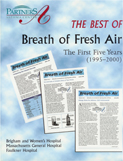Breath of Fresh Air: Feature Articles
Chapter 38: Does everyone with asthma need a home compressor and nebulizer to deliver bronchodilator medications in a emergency?
A. If you have ever had a severe attack of asthma that required urgent care in a doctor’s office or emergency department of a hospital, you have probably been treated with nebulized bronchodilators. A nebulizer takes a liquid solution of medication and transforms it into a fine mist for inhalation. For an acute asthmatic attack, the medication most often used is albuterol (brand names: Proventil® and Ventolin®). Nebulized albuterol works as well as the injections of adrenaline (also called epinephrine) that used to be standard emergency room treatment for acute, severe asthma.
Nebulizer systems are available for use at home. They can be rented from respiratory home-care companies or purchased at many pharmacies for about $120. In the home system, the nebulizer is driven by compressed air. The compressor runs on electricity and is about half the size of a toaster oven. Battery-operated systems are available but are considerably more expensive. The medication to be nebulized, such as albuterol solution, requires a prescription from your physician.
Persons with difficult-to-control asthma and frequent severe attacks may choose to have a nebulizer system at home rather than rely on emergency trips to the doctor’s office or hospital. Anyone who has ever had a life-threatening asthmatic attack that came on over a short period of time should probably have a nebulizer system at home to administer powerful bronchodilator medication quickly while awaiting additional emergency care. Many parents rely on nebulizers to deliver asthmatic medications to their small children. The mist is breathed from a mouthpiece or face mask and, unlike the metered-dose inhalers with pressurized medication canisters, requires no special coordination to use.
Not everyone with asthma needs a nebulizer. Even in an acute asthmatic crisis, bronchodilator medication can be administered using the metered-dose inhalers with good effect. Many scientific studies have shown that bronchodilator by nebulizer and bronchodilator by metered-dose inhaler give identical results when the following conditions are met: enough puffs of medication (usually 4-6 puffs) are taken as one treatment; one waits one minute between each puff; a spacer device (for example, Aerochamber®, Optichamber®, or Inspir-Ease®) is used to improve inhalation technique; and one carefully inhales each puff delivered from the metered-dose inhaler. If you carry a beta-agonist bronchodilator inhaler with you, you are prepared for most acute emergencies of your asthma.

